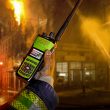Measuring 800 MHz interference
In recent years, 800 MHz public-safety systems have encountered increasing amounts of interference. Much of that interference has to do with commercial mobile radio services, or CMRS, providers operating systems on channels in close proximity to those utilized by public-safety entities. Given the homeland security obligations of the nation’s public-safety agencies, it is imperative that their communications are robust, highly reliable and free from harmful interference.
The FCC has adopted a plan designed to address the harmful interference to public-safety communications systems operating in the 800 MHz band (see news story on page 6). The plan has both long- and short-term objectives. Over the long term, the FCC’s plan calls for separating generally incompatible technologies. In the short term, the FCC has implemented objective technical standards — called “enhanced best practices” — for defining unacceptable interference to public-safety systems operating in the 800 MHz band and procedures detailing the responsibilities and expectations regarding abatement of such interference.
The FCC’s plan will result in an additional 4.5 MHz in the 800 MHz spectrum — the equivalent of 90 additional two-way channels — becoming available to public safety, critical infrastructure and private wireless users, including 10 channels for public-safety/critical infrastructure interoperability.
Even with the spectrum changes adopted by the FCC, interference will remain a concern. Accurately measuring interference will go a long way toward ensuring the performance of public-safety networks. However, there is more to it than simply measuring interference. Locating the source of interference so that it can be corrected quickly is equally important.
There are two basic types of interference: in-channel signals and noise, and out-of-channel signals. Each applies to both licensed and unlicensed systems.
In most licensed systems, the frequency allocation process — as well as antenna positioning applications and approvals — prevents overlapping signal paths and unexpected interference. No two systems are deliberately licensed to use identical channels and physically interfering signal paths. So, in-channel interference from other systems generally is not expected, although unintended antenna misalignment can put signals where they don’t belong. Typically, when licensed systems interact, the likely cause is out-of-channel signal effects.
Out-of-channel signals that cause problems for an affected receiver are generally found in areas close to high-power transmitters. These conditions are not unusual when the affected communications system shares common real estate with high-power transmitters, such as the highest points in an urban area, which are prized for the large signal footprint they afford broadcast stations. The two primary interference mechanisms are desensitization and intermodulation.
Desensitization occurs when a legal high-power transmitted signal enters the typical affected receiver and overpowers the designed rejection capability of the front-end RF filter. As the high-power signal comes in, the automatic gain control, or AGC, of the affected receiver cuts back its own amplification. In that action, the amount of gain required for proper signal-to-noise processing of the needed data is reduced. Interference also can clip off the crest factor peaks of digitally modulated signals, including bit errors.
Intermodulation occurs when high-power, out-of-channel transmitters interact to create new signals that appear in the passband of the affected receiver. In order for such signals to intermodulate, there must be an external electrical non-linear element present.
In crowded real estate with many high-power transmitters, non-linear detection can cause the re-generation of multiple intermodulation cross products. If any fall within the affected receiver passband, they reduce the carrier-to-noise (C/N) ratio of the system.
Because the interfering process usually involves overlapping frequencies, a hand-held spectrum analyzer is the test instrument of choice because it conveniently captures and displays such signal overlaps. To ensure accuracy and measurement confidence, the spectrum analyzer should have powerful measurement functions and control key routines that can enhance the technician’s time and skills. Some of the critical functions are markers, preamplifier, demodulation, field-strength parameters and occupied bandwidth/channel power.
Field technicians can use marker controls to identify the frequency of the interfering signal. Marker controls also highlight the simplicity of today’s hand-held spectrum analyzers. If the interfering signal is higher than the intended affected channel signal, the technician simply has to press a key on the spectrum analyzer. An annotation on the display will indicate the frequency and power level of the signal at the appropriate marker position. If the interfering signal is smaller in amplitude than the affected channel signal but still overlaps the signal, the technician can move the marker key to the center of the display. The technician then can reduce the span containing the interfering signal to make it easier measure or identify.
When received signals are weak, which often is the case for field measurements, the preamplifier function becomes important. A preamplifier can add as much as 20 dB of gain at the front-end input. It isn’t permanently wired into the spectrum analyzer because it will be saturated when larger signals are measured. Therefore, it should be used judiciously and with knowledge of the signal environment.
The demodulator function is important if there is AM or FM modulation in the interfering signal. This is common if there is a powerful AM or FM station tower nearby. The demodulator function allows the field technician to select either AM or FM, which is determined by the RF frequency characteristics. Once that is selected, the technician can actually hear the audio on either an internal speaker or plug-in headset.
Identifying interfering signals often requires relative quantities, such as affected signal versus interfering signal, and can be measured in dB ratios. There are occasions, however, when the absolute field strength units need to be measured. One example is when technicians must determine field strength at the affected signals.
Occupied bandwidth, or OBW, allows technicians to define the band edges of an occupied band by defining the RF power points. After the measurement is conducted, the markers are displayed as annotated frequencies on the display and define the band edges where the signal is 20 dB below the carrier. Complementing OBW is channel power, which arithmetically computes the integrated power contained within its defined bandwidth. This mode integrates the power contained within defined OBW.
All of these measurements can be made easily with today’s hand-held spectrum analyzers. Many of the control settings and common measurements can be pre-set by engineering management, stored in the spectrum analyzer’s memory and recalled by technicians in the field. This is especially useful when the site under test is routine and repetitive or if the spectrum analyzer is being used when measure standardized frequencies and bandwidths.
There are two configurations in which a hand-held spectrum analyzer can be used to measure interference. One is to directly connect the instrument to the affected system’s antenna, and the second is to use a portable antenna with the spectrum analyzer.
A spectrum analyzer exhibits approximately the same sensitivity as a typical affected system receiver and can be connected into the communications system antenna in place of the affected system receiver. Also, the spectrum analyzer can be easily connected to the system combiner/splitter by unscrewing the signal cable and connecting it to the spectrum analyzer input.
When not connected to the communications system antenna, the spectrum analyzer still can conduct interference measurements via an independent antenna that utilizes a “whip” design. A whip antenna is a linear conductor connected to the coaxial input connector on the spectrum analyzer.
Each antenna is sized for one-quarter wavelength at the specified center frequency. Some whip antennas are also “inductive-loaded,” i.e., their physical length is not equal to the one-quarter electrical wavelength. Whip antenna designs are omnidirectional so they are insensitive to directional efforts.
For additional diagnostic power in certain interference measurement situations, the operator must use a directional antenna. In those cases, a directional antenna attached to the spectrum analyzer can help determine the direction from which an interfering signal is arriving. Obviously, this makes it easier to find the location of the interfering signal’s source.
Donn Mulder is the field solutions business unit manager for Anritsu Co. He earned a bachelor’s degree in electrical engineering from Iowa State University and has been involved in the test and measurement market for 25 years.
Interpreting dB power displays on a spectrum analyzer
When using a spectrum analyzer in its logarithmic display mode, typically 10 dB per division, adding the displayed signal powers from several sources is not immediately obvious. In the figure, the main affected Signal A is shown flat at -50 dBm. An interfering Signal B is shown having the same -50 dBm power level.
The sum of two different signal traces is not the added physical heights of the two displayed traces. Decibels are logarithmic values so they add in non-linear fashion. When Signals A and B add together to form a single trace — though they create a combined linear power that is twice the amount of either — the displayed logarithmic power is just +3 dB higher.
Likewise, when Signal A combines with Signal C, since Signal C is 10 dB lower than Signal A — meaning only one-tenth the power — the combined power of A and C is 10% higher, or 1.1 times the power of Signal A. This logarithmically adds to only +0.42 dB higher than Signal A, as shown.

















